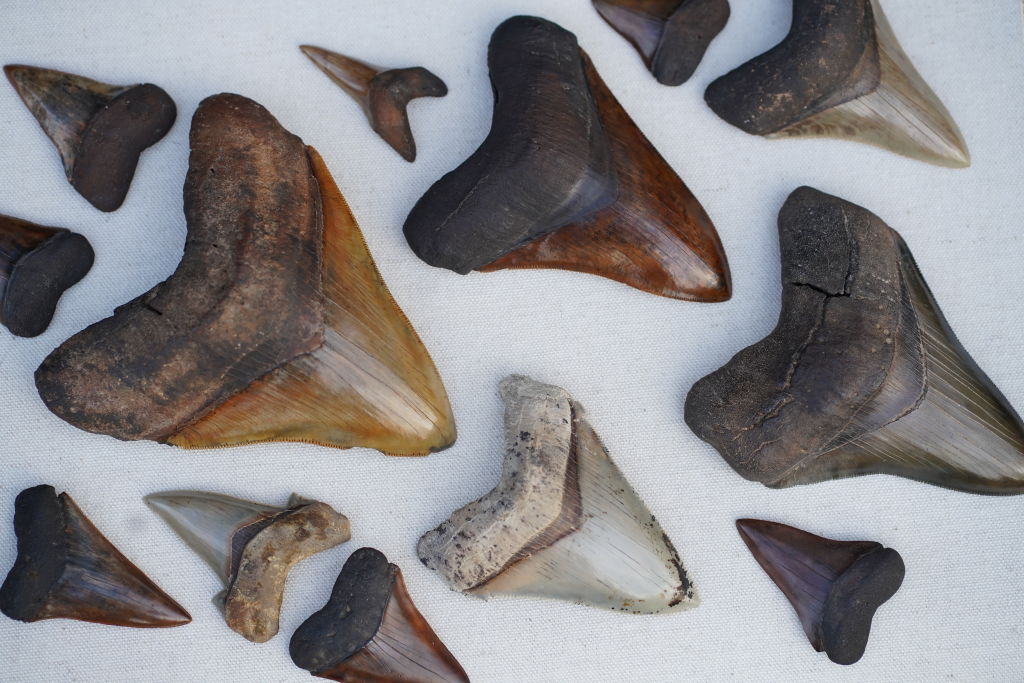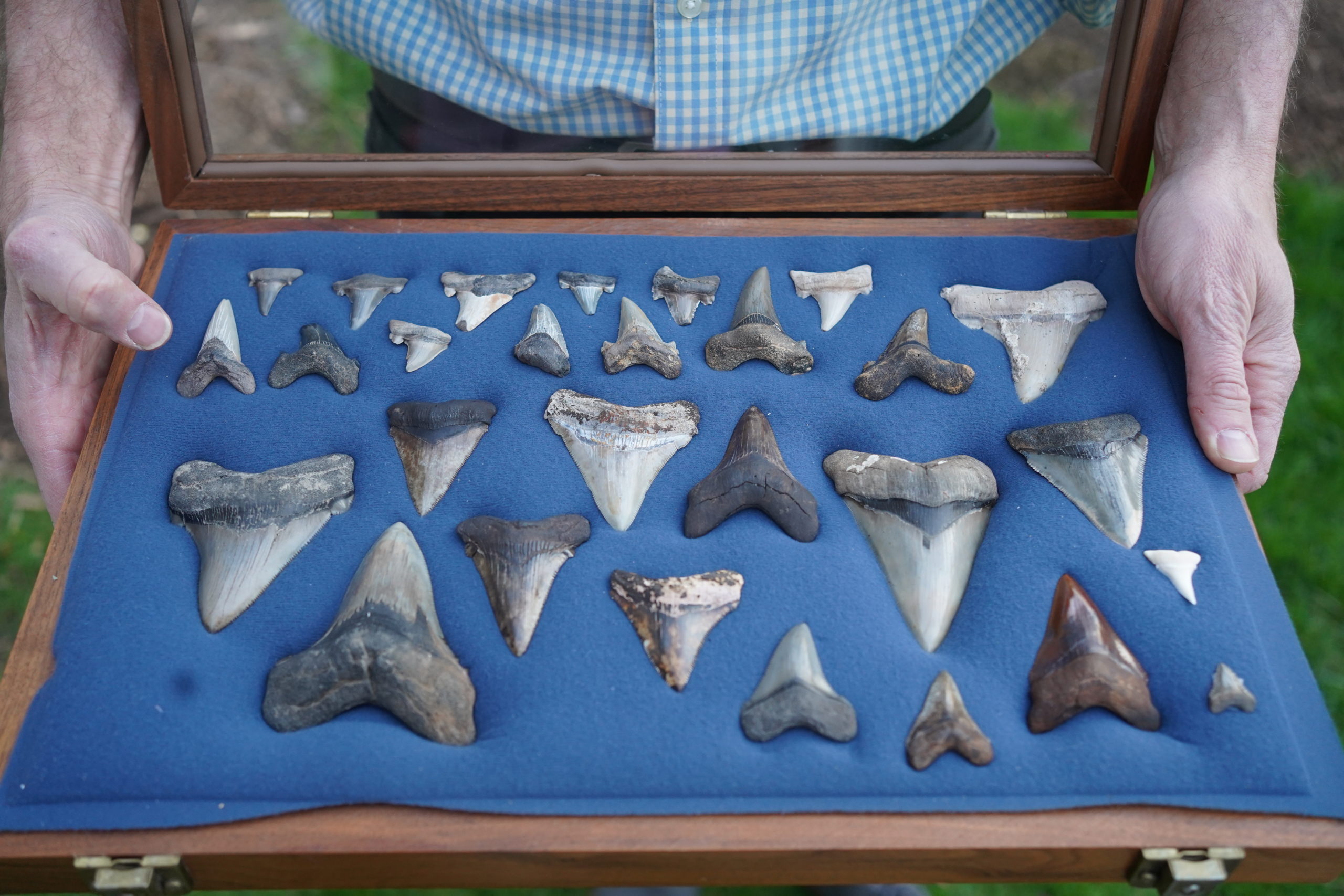Play
 Alford’s collection of teeth from mako sharks and ancestors of the megalodon, spanning 7.5 million years old to 30 million years old. Photo by Nicole Schaller.
Alford’s collection of teeth from mako sharks and ancestors of the megalodon, spanning 7.5 million years old to 30 million years old. Photo by Nicole Schaller.
Stories From Beneath the Surface: Insights From an Expert Diver
April 29, 2022 @ 9:00am
This summer offers a renewed possibility for travel. There’s a collective desire to seize opportunities for adventure, like scuba diving. Exploring the world below the water’s surface is on many people’s bucket lists. Get inspired by reading our interview with an expert diver and paleontologist who explores intense waters for fossils. Also, we’ve created a comprehensive beginner’s guide for people who want to take the plunge. Read the guide here.
When Dr. Aaron Alford decided to learn to scuba dive, it wasn’t for recreational purposes.
“I got certified so I can work,” says Alford, the senior director of research and evaluation at the National Association of County and City Health Officials (NACCHO), who is also a professional paleontologist. “And while doing that, I fell in love with just being underwater.”
In June 2009, he and a colleague decided they wanted to excavate rivers and brackish waters to look for fossils dating as far back as 540 million years. To Alford’s knowledge, they were the only two people doing underwater stratigraphy in rivers at that time.
Alford describes the conditions of his normal dives as “water the color of coffee. When you get to 10 feet, there’s no ambient light. It’s like being in a cave in the center of the earth. The water is smelly because it’s swamp water and often running very fast at five to six knots (7 mph). Nobody wants to dive in those conditions.”
As a result, Alford had to learn how to adjust and adapt to meet the conditions of the quarry site.
“For a lot of [standard] dive trips, they will say it’s a current dive, which means they drop you off in one place and let the current take you to another place by drifting. With the work we’re doing,
we want to stay in one spot because we’re acquiring a skull or taking samples. So, my gear is very stripped down. There’s no stuff floating around me like you would normally have if you’re just diving on a reef.”
To combat floating away from the quarry site, Alford wears a pick on a lanyard which he’ll jam into the bottom of the river to anchor himself. He’ll also wear significantly more lead than a natural buoyancy diver.
“I drop to the bottom of the river and hang on for dear life.”
Although his expedition environments are harrowing and take a lot of skill to maneuver, Alford approaches the dives as a meditative endeavor.

One of Alford’s shark teeth collections. Photo by Nicole Schaller.
“When people talk about sensory deprivation tanks or about Zen meditation, they talk about becoming super-focused. It’s up to you. I’m usually focused on getting calm and quiet so I can find things and see the stuff I need to for [my] work. I’m to the point now where I’m jonesing for my next dive because it’s the most relaxing, meditative thing I can think of.”
Alford is so relaxed when scuba diving, he has trained himself to breathe once every 10 seconds to conserve oxygen. When using a larger tank, he can stay underwater working for two hours.
At the same time, his expeditions are full of stimulating journeys fit for Indiana Jones in a wetsuit. His encounters include dodging bull sharks to playing with crawdads on the bottom floor, to swimming through a hollowed-out tree trunk to discover a 100-pound catfish with its mouth wide-open. Each dive is full of surprises.
“I came across blue crabs taking freshwater clam shells and banging them against rocks to open them up,” Alford recalls. “That’s never really been described in the literature.”
Ever the scientist, what brings him the most joy is discovery.
“In a quarry, we found a couple of complete skulls of tiny dolphins, which are the size of a [small human child’s] skull. They were commissioned to the museum collection and are 19 million years old.”
Alford showed me boxes upon boxes of shark’s teeth, whale bones and shipwrecked treasures. But that only scratches the surface.
“My home run, and what keeps me glowing and going for years are new species. This past year, my buddy and I found a 300-pound giant monster of a baleen whale skull. It was a significant contribution because there were no intact specimens of baleen whales from this layer of the earth and it’s probably a new species.”
Scouring sites throughout Virginia, Alford has unearthed a number of potential new species, including Callorhinchus alfordi, a type of rat fish named for the scientist.
While his experiences are vastly different than what any beginner can anticipate, his love for exploring underwater is inspiration enough. And Alford did offer some parting words of advice.
“You can laugh, scream or cry wearing a regulator. I’ve done it all.”
Enjoy this piece? Consider becoming a member for access to our premium digital content. Support local journalism and start your membership today.







